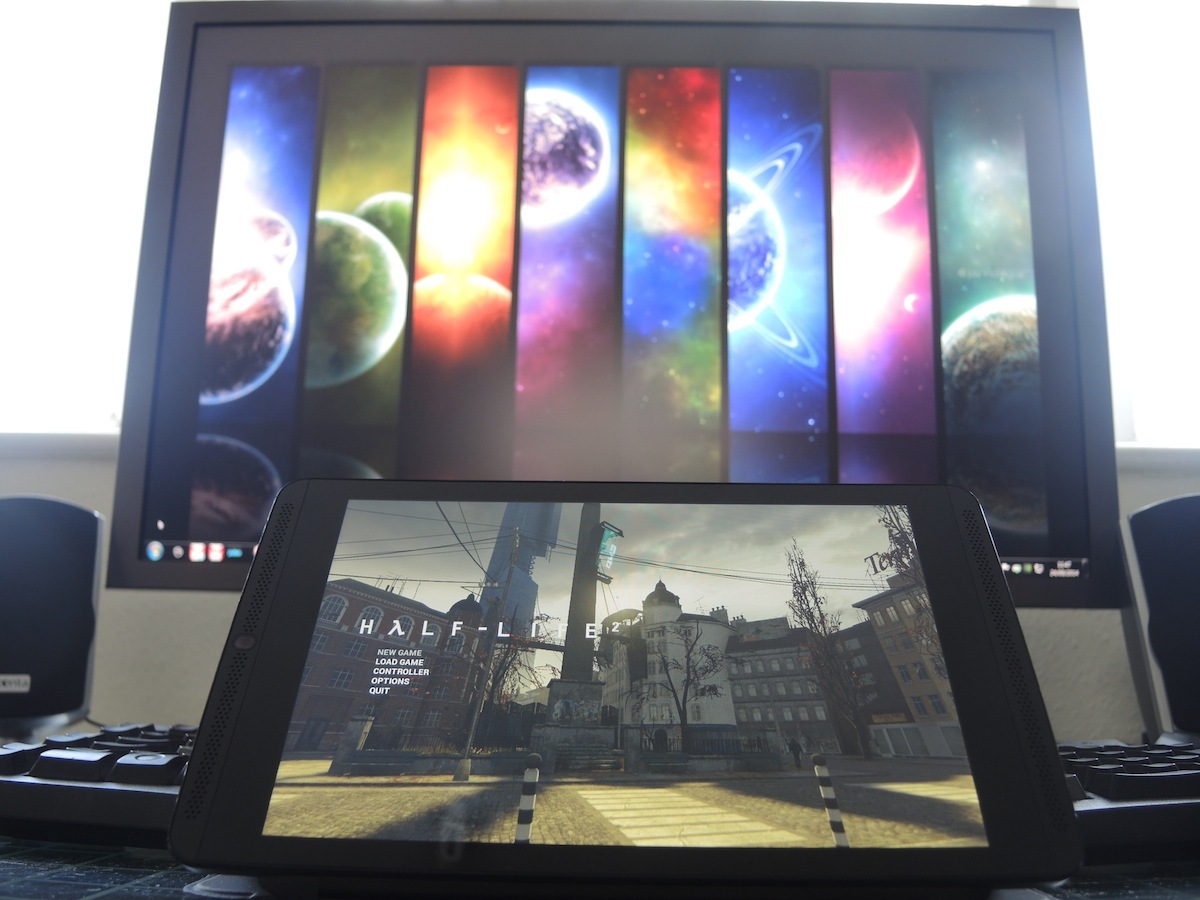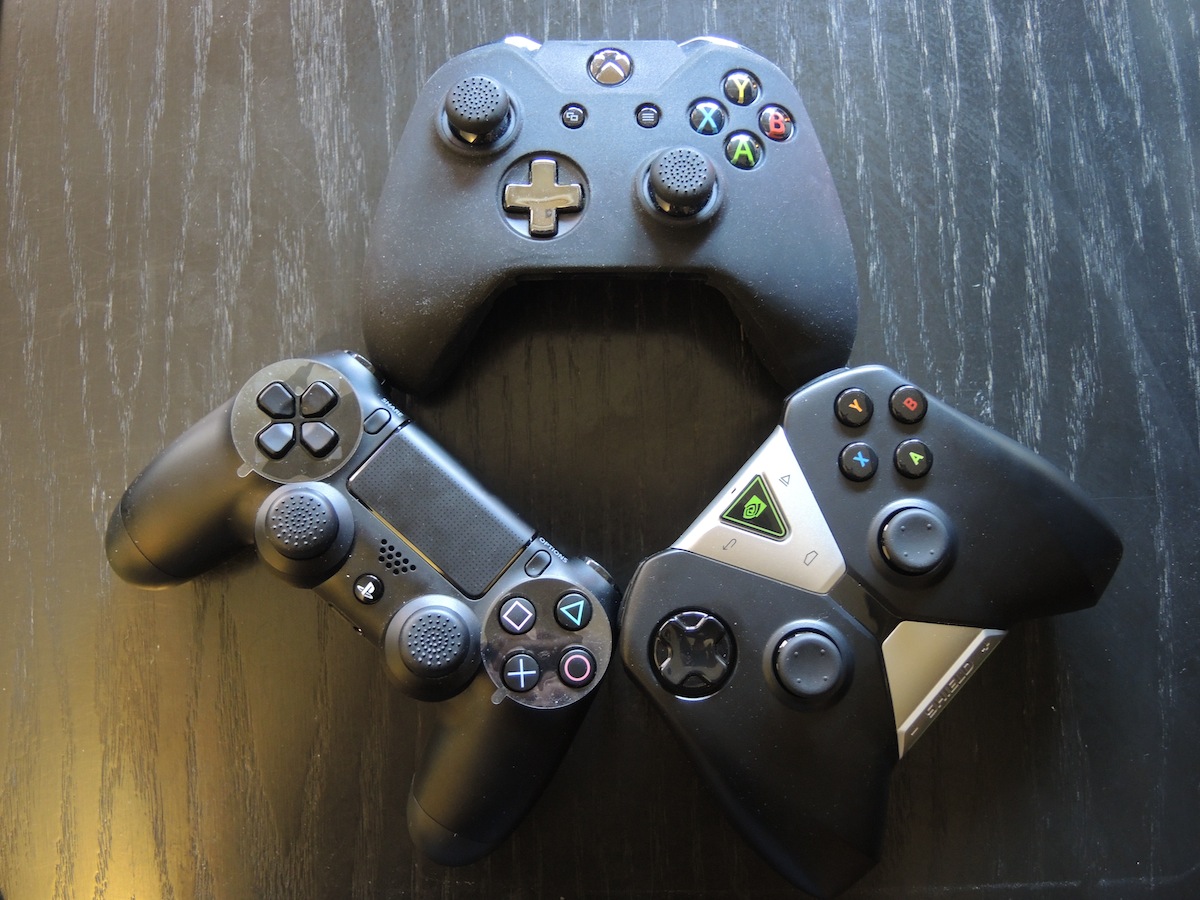Nvidia Shield Tablet review
We put Nvidia’s miniature mighty slate through its paces to see if it really is the best gaming tablet ever made
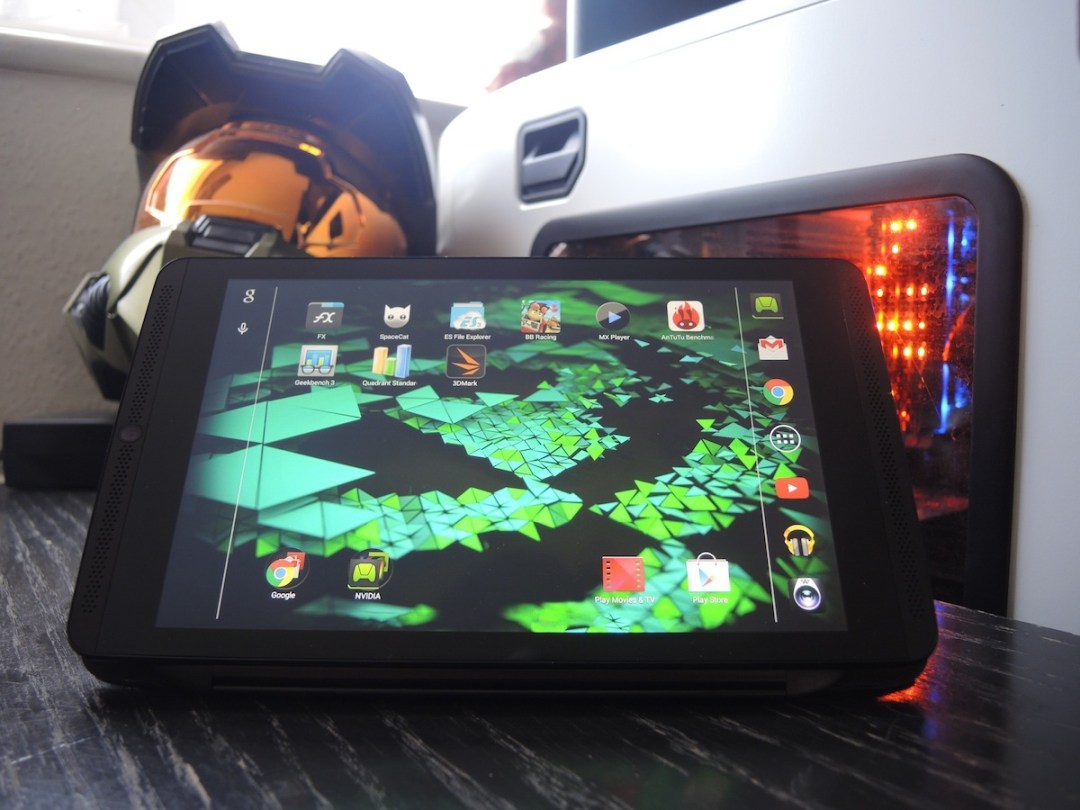
Game how you want, where you want.
That’s Nvidia’s tagline for its Shield Tablet, and it promises to open up a world of super powerful on-the-go gaming, thanks to the beastly Tegra K1 processer that lurks beneath its shell.
Promising an unparalleled Android and PC game-streaming experience, the Shield certainly isn’t shy when it comes to selling itself. But does it live up to the hype?
Simple yet solid
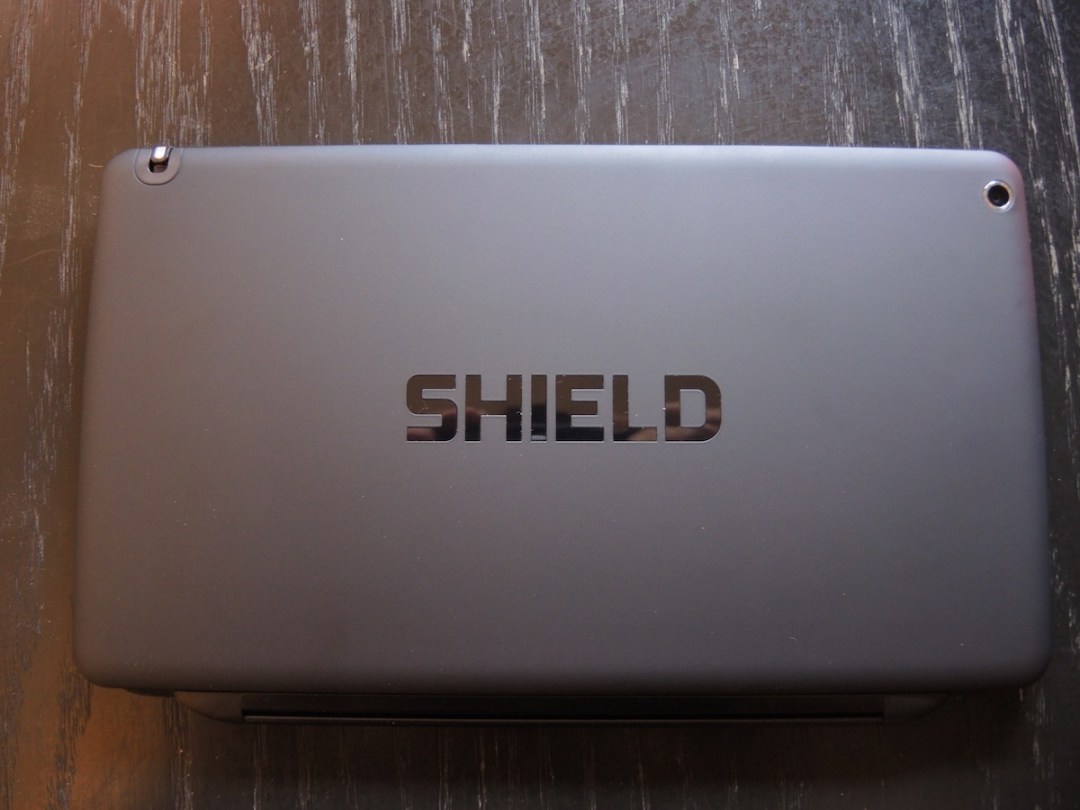
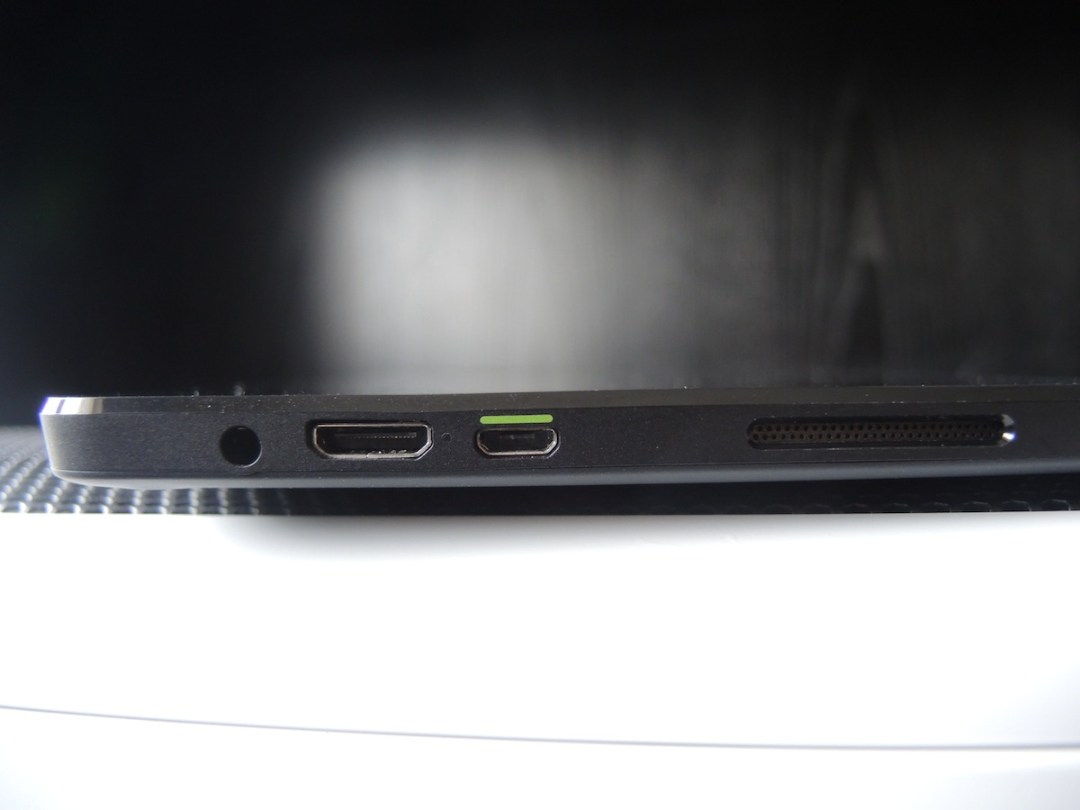
At first glance, the Shield Tablet looks like a giant HTC One, thanks to its rounded corners and dual front-facing speakers.
Unlike the HTC and the iPad Air however, there’s no metal in sight. The rear of the Shield is slathered in plain black matte plastic, and while obviously not as premium as metal, it looks smart and feels pleasantly grippy.
It also feels reassuringly weighty in the hands and doesn’t creak or flex if you try to bend it.
Camera-wise, there’s a 5MP front-facing offering for video chat and (shudder) selfies, along with another 5MP snapper on the rear, both without a flash.
The left hand side remains bare, leaving room for an optional (but in our opinion, necessary) magnetic cover which doubles up as a stand. The cover itself is soft on the inside and made out of tough, durable rubber on the outside, which should protect the screen from any accidental drops, although it won’t do anything to save the rear.
The right side of the Shield features a power button, volume controls, a microSD slot for expandable storage, a stylus slot, and a mini HDMI port. More on those last two later and on the top you’ll find a bass speaker vent, a headphone jack and a microUSB port.
The Shield’s dual front-facing speakers pack quite a punch for a tablet. They’re loud, crisp, and don’t distort, even at higher volumes with a HTC BoomSound-esque quality to them.
Overall, the Shield Tablet’s design is safe and solid. It won’t draw eyes on the catwalk, but that’s OK, it doesn’t need to. The build quality – bar slightly squishy volume and power buttons – coupled with its grippy rear makes it comfortable in hand.
A screen for gaming
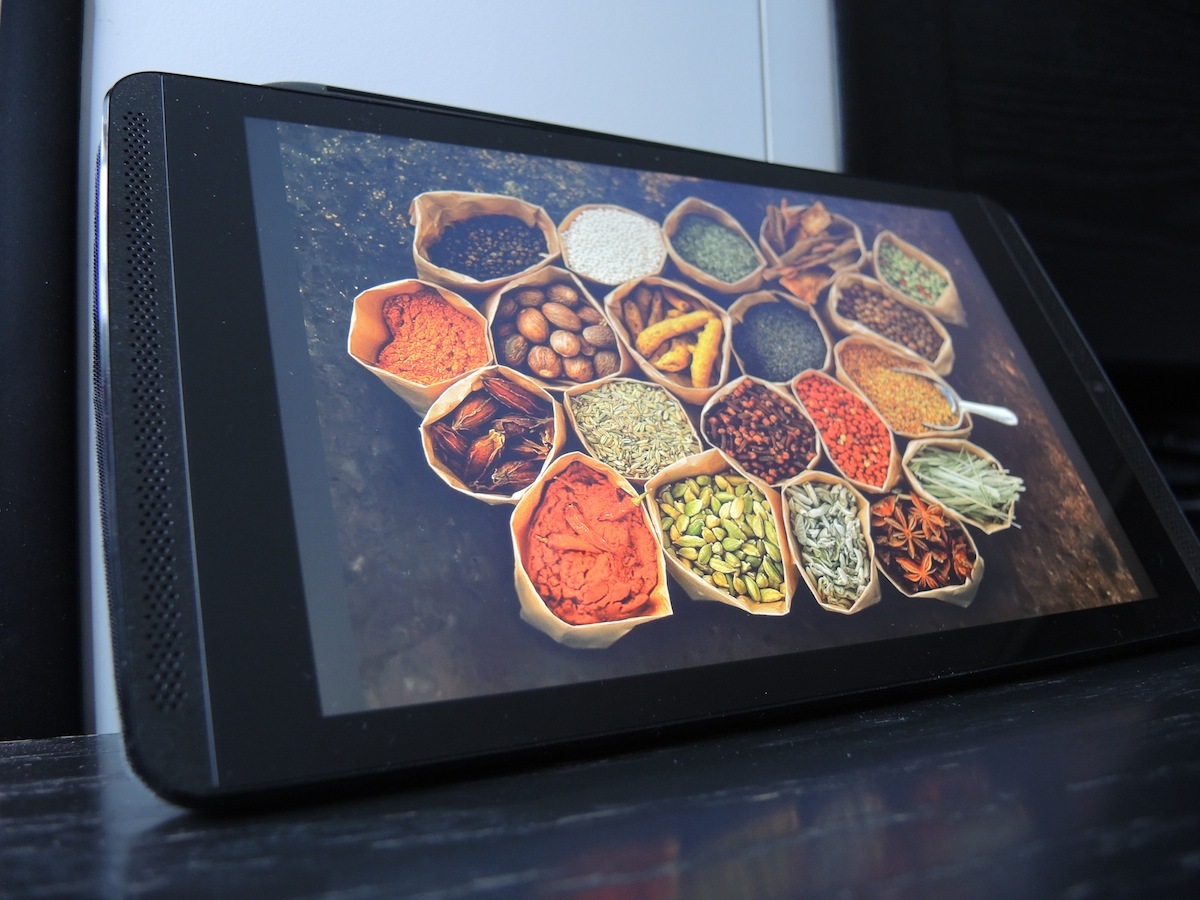
The Shield Tablet’s 8in Full HD IPS screen looks lacklustre on paper when compared to the likes of 2K slates like the Samsung Galaxy Tab S 8.4.
In general use however, you won’t notice its lower 283 ppi count. Not unless you spend the majority of your time tapping away at the screen with your nose that is.
Colours on the Shield’s bright display are well-balanced, serving up bright, vivid hues without suffering from unrealistic oversaturation.
The same can’t be said for the contrast however. While IPS panels can never match the true blacks of an AMOLED display, blacks on the Shield’s screen look more of a dark grey in comparison to the iPad Air.
The difference in whites is even more noticeable. Next to an iPad Air, whites on the Shield look positively dark and creamy, and are begging for a sprinkle of Daz.
Generally though, you only notice this sort of stuff when you’re meticulously comparing different screens side by side. In general use and gaming, the Shield’s screen is still sharp and pleasant to look at, and you shouldn’t have any complaints.
Our only other complaint is that you’ll struggle with glare if you’re using it outside, which could make headshots a problem when you’re spraying bullets at enemies. Still, it’s unlikely you’ll be doing this beneath the glaring sun on a park bench so it‘s not a dealbreaker.
Stick that in your benchmark pipe and smoke it
The Tegra K1 processor that’s nestled within the Shield’s unassuming black shell is an absolute beast. We don’t like getting bogged down in numbers as real-world experience is always more important, but we couldn’t help ourselves:
Antutu: 52,796
Those numbers mean nothing on their own of course, so let’s try and put them into perspective. The 3D Mark score isn’t massively far away from the Acer Iconia W701’s score of 39,592 – and that’s running an Intel Core i5 processor.
Its Antutu score also comfortable beats pocket powerhouses like the mighty Galaxy S5 and HTC One (M8) by almost 10,000 points and it scores higher than the Galaxy S5 in Geekbench too.
Tegra K1 Time
High numbers are impressive of course, but they still don’t mean anything at all if lag and stuttering is present.
Thankfully the Shield has neither, and Android 4.4 runs smoother than a greased-up cheetah.
Multi–tasking, app switching and of course gaming, are all handled with ease thanks to a combination of that beastly K1 processor and 2GB of RAM.
This is meant to be more than just a regular Android tablet however. We want more than just snappy apps. We wanted a truly portable, no-compromise gaming experience. And the Shield delivers.
A gaming portal in your hands
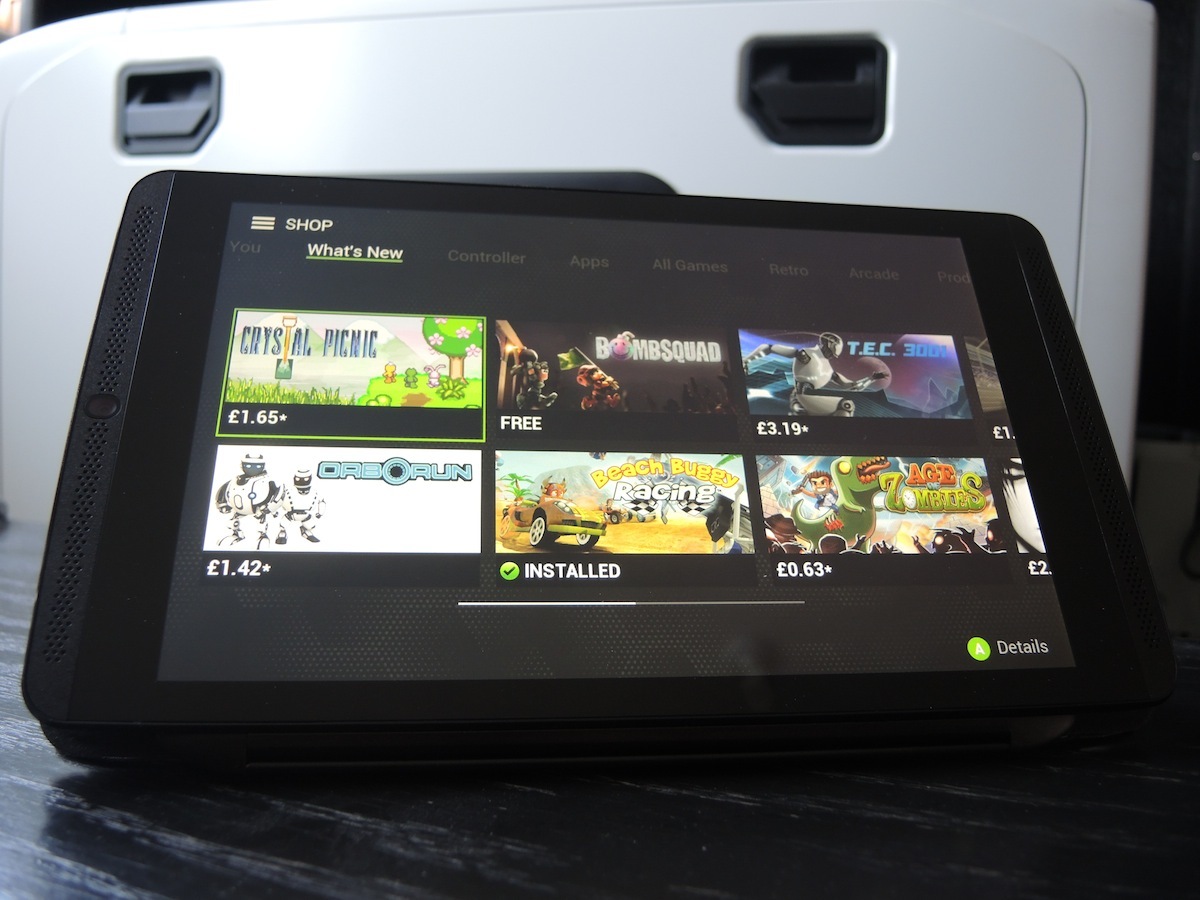
Vegetarians turn away now. You’ve reached the deliciously succulent meat of this review.
The Shield is billed as the ultimate gaming tablet, and for the most part, it absolutely delivers.
There are a number of ways you can enjoy games while you’re on the move. The simplest way is to play existing Google Play store games and obviously they’re handled with ease. But that’s boring, and it’s certainly a waste of that powerful Tegra silicon.
Enter the Nvidia Hub.
It’s a dedicated portal to made-for-Shield games that take advantage of all that power, and includes heavy PC-hitters such as Half Life 2 (sold separately).
Valve’s legendary FPS is handled extremely well by the Shield’s innards. It looks sharp and plays smoothly, and it’s quite humbling to think that it outperforms the below-par PC we first tried to run it on nearly ten years ago.
Combined with a mini HDMI cable (which annoyingly isn’t included in the box), the Shield brings Half Life 2 to a 25in 1080p monitor, effectively turning it into a portable gaming PC/console.
There’s more. Trine 2 is a side-scrolling adventure game that’s pre-installed and included in the price of the Shield. We had trouble getting it up and running and had to faff around re-installing it, but managed to get it running in the end.
Its bright fantasy world looks fantastic both on the Shield’s display and on an external monitor, and it should keep both younger and older gamers occupied in the first few hours of owning a Shield Tablet.
So that’s the Shield’s gaming prowess taken care of. Almost.
Free your gaming rig
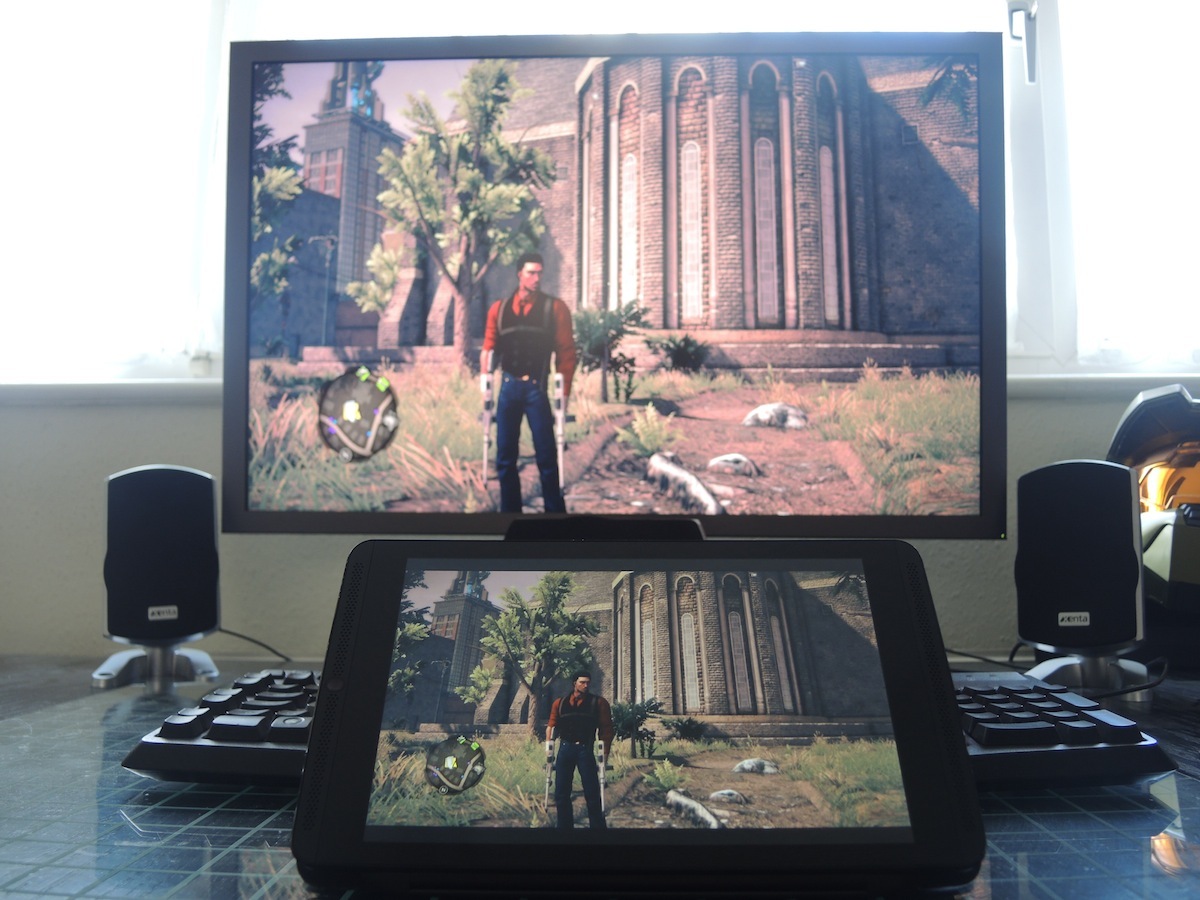
If you’re the proud owner of a PC gaming rig, you’ll know that they’re generally not too happy with being lugged around.
Well, not quite. They probably don’t care either way, but your spine definitely will, especially if there are stairs involved.
The Shield Tablet solves this problem by streaming games from your PC straight to its 8in screen, letting you use its controller to game away from your Pixel Den.
We ran Far Cry 3 and Saints Row IV on the Shield Tablet while it was connected to a 1080p monitor downstairs, while our PC happily churned away in another room. And there was no lag whatsoever.
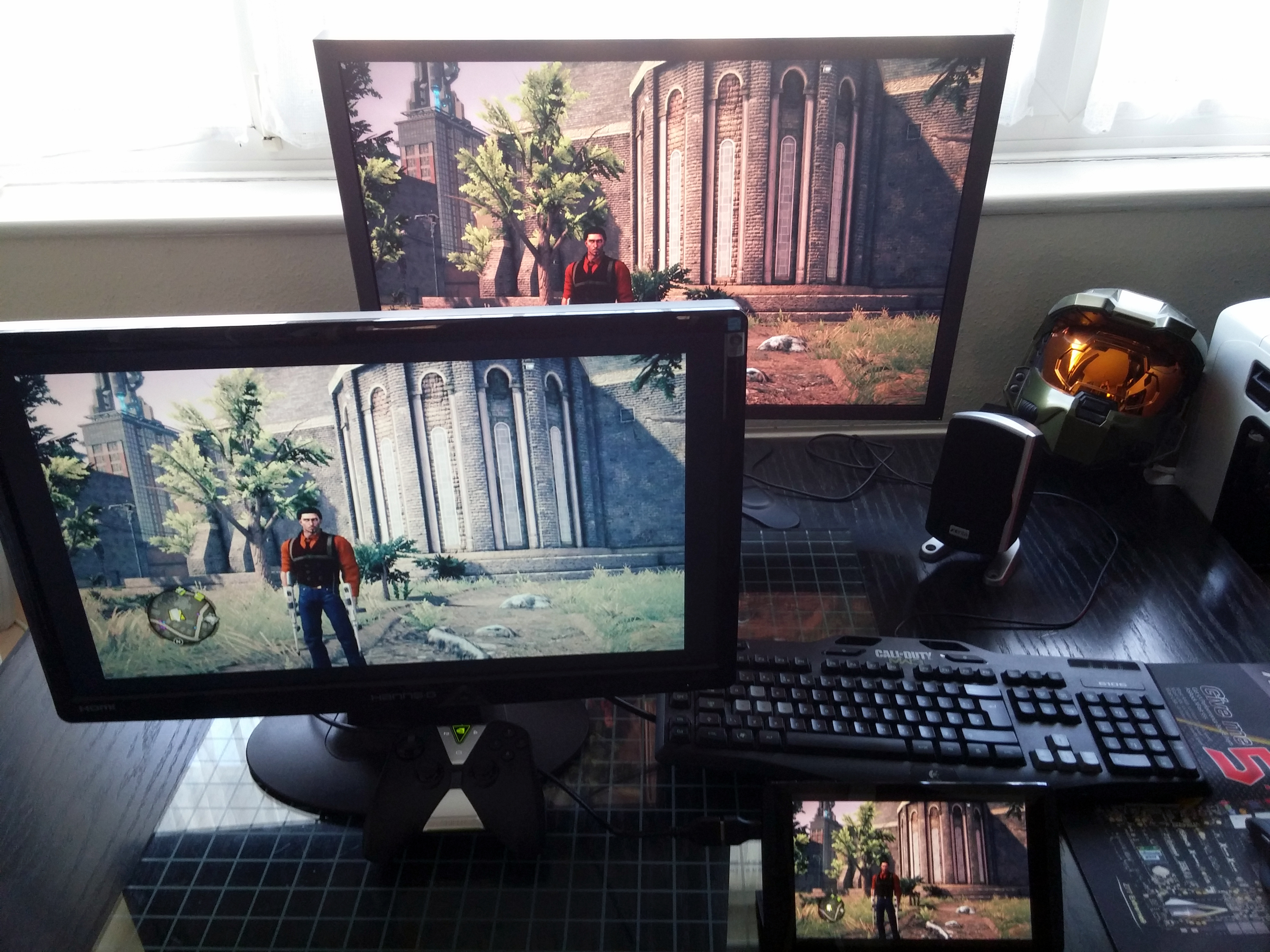
It’s even possible to stream a PC game on two monitors and the Shield’s screen simultaneously, in a gluttonous display of gaming escapism.
Setting up requires a capable gaming rig with at least an Nvidia 600 series card or higher, and you’ll need to install the GeForce Experience software too. Once that’s done though, it’s a simple matter of entering a pin, and boom – you’re good to go.
We ran into a few audio niggles with Far Cry 3 in which sound was still being sent to the PC speakers, and we couldn’t fix it ourselves.
Other games worked flawlessly, so we’re putting that down to a random bug for the time being.
We had no luck streaming games when tethered to our smartphone either so you’ll need a fast, strong Wi-Fi connection to take advantage of game streaming on the go. Sadly, that probably means Starbucks probably isn’t going to cut it but it is an option.
The Controller
Nvidia’s £50 wireless controller is as essential to the entire Shield experience as its £25 stand-cum-cover.
Buying the Shield Tablet and not having the controller is the equivalent of having a Ferrari without power steering. Sure you can drive it, but it’s going to be the opposite of fun.
While the Shield is compatible with other Bluetooth Android controllers, its own controller works over Wi-Fi to reduce lag, and its quality rivals that of the Xbox One and PS4 gamepads.
It felt rather large and chunky in our hands initially, presumably due to our recent PS4 Destiny marathons. Sony’s DualShock 4 is still relatively slim and dinky compared to the competition, but it didn’t take long for our hands to adjust.
All the regular controls you’d expect are present and accounted for. Two triggers, two shoulder buttons, two joysticks, a D-Pad and four action buttons are all where they should be.
There’s also a few touch-sensitive buttons in the middle, with a large green one taking you straight to the Nvidia Hub, along with home, back and start buttons surrounding it.
The bottom of the controller has clickable volume buttons, located beneath a trackpad which works exactly like a laptop’s offering, albeit in a smaller, more awkward way.
Thankfully it’s built like a tank, and everything from the triggers to the joysticks feel sturdy and grown up.
Naturally it still can’t hold a candle to the precision offered by a keyboard and mouse, but no controller can. The Shield Tablet itself does support Bluetooth keyboards and mice for the truly fussy gamer.
Overall while £50 is pricey, it’s built to last. Our main gripe with it is that it doesn’t double up as a PC controller too, which would have been a nice way to save some cash.
Nvidia Shield Tablet tech specs
Screen: 8in 1920 x 1200
Processor: Nvidia Tegra K1
RAM: 2GB
Storage: 16GB (expandable with microSD)
Camera: 5MP rear, 5MP front-facing
Battery: 19.75Wh
Dimensions: 221 x 126 x 9.2mm
A familiar OS
With everything else we’ve talked about, it’s all too easy to gloss over Android. And there really isn’t much to say here.
The Shield is running Android 4.4 KitKat, and Nvidia has mercifully left things alone for the most part. No garish themes or tonnes of complicated menus in sight.
There are just a few Nvidia extras like the Hub and Twitch streaming controls, along with the Dabbler stylus software.
Beyond that, it offers everything you’ve come to expect from Android, including full access to the Google Play Store, and it all runs fluidly without any slowdown.
A decent camera that streams your game face

If you insist on using the Shield’s 5MP camera, then expect to get decent shots in well-lit conditions, though don’t count on cropping them at all – there aren’t enough megapixels to retain the detail. The HDR mode is decent and its ability to manually select the focus and exposure points independently is also rather useful. But the lack of an LED flash results in low light shots that look like they were taken with a lens smeared with Vaseline and dust.
If you really want to annoy us and take a selfie with a tablet, then its 5MP front-facing offering does a decent job too.
Incidentally, though, that front-facing camera can also be used to stream your face to eager fans on Twitch – the videogame streaming service that lets gamers watch other gamers… game.
We played through a few levels of Trine 2, Master Chief helmet in front of our heads to boot, and still didn’t get any viewers. But hey, if you’re more popular than us, you’ll be glad to know that streaming works well, without impacting on the smoothness of games you’re playing.
Stylus smarts
Gaming muscle isn’t the only trick the Shield has in its arsenal. Remember that stylus we mentioned earlier?
Pulling it out prompts you to launch Dabbler, Nvidia’s own painting/sketching app, which makes use of the Shield’s powerful GPU to provide some fancy effects, like gravity-affected water colour dripping.
The set up is a bit basic in its functionality – seasoned artists should look to more complete apps like Skectchbook Pro, or the Galaxy Note 4’s active pressure sensitive Wacom stylus – but it’s still fun doodling around.
More impressive is the Shield’s handwriting recognition. It can decipher our appalling scribbles 99% of the time, and though typing is still faster, it’s still satisfying to watch our handwriting magically transform into legible text. OK, it’s nothing new but our gadget fancies still get tickled all the same.
Battery life
The Shield will comfortably last a day of fairly heavy use – namely playing some Android games, web browsing, watching some shows on Netflix and sending emails. You could get away with not charging it by the time you get to bed, but you might struggle to get another full day out of it.
When it comes to more demanding local games like Half Life 2 and streaming PC games however, the Shield will conk out somewhere between three to four hours. S we’d recommend gaming while it’s charging, just in case you need to dash off and need it to last for a while.
It lasted around five and a half hours in our HD video loop battery test (screen at 50% brightness, Wi-Fi and sync on). That’s acceptable but falls substantially short of the stamina of the iPad Air, its Mini brother or the Samsung Galaxy Tab S series.
It appears to be the price you pay for power but stick to gaming near a power socket and you should be fine.
Verdict

The Shield Tablet really is the ultimate gaming tablet. There’s absolutely no question about that.
Its insides are scarily fast, handling anything that even the latest Android games can throw at them with ease.
Made-for-Shield games look amazing and play well, and PC game streaming is easy to set up and works seamlessly.
The trouble is, there aren’t enough made-for-Shield titles out there to warrant the cost of the Shield Tablet, a cover and its controller alone – a combined total of £315.
Until the hardware of other manufacturers choose to catch up, the Google Play Store won’t be full of titles that take advantage of the Shield Tablet’s gaming muscle either.
That leaves PC game streaming as the main reason to snap up a Shield right now. If you’re the owner of an Nvidia-powered gaming battle station and want to enjoy your library in other rooms or locations without breaking your back, then it’s a very convenient, very capable solution.
More casual gamers who don’t own a 1337 gaming monster might be better off spending their money on the much cheaper Sony PS Vita – especially if they have a PS4, as that offers console game streaming straight to the Vita’s screen too. An iPad Mini with Retina Display (which offers a better variety of regular apps and games) can also be snapped up for £320.
Cost and niche appeal aside, we salute Nvidia for producing a tablet which ticks all the right tech-head boxes. If you’re after the most powerful tablet and a portable PC gaming experience, look no further.
Buying one? › Order your Nvidia Shield Tablet from Maplin here
Stuff Says…
The Shield’s sheer power and gaming smarts are incredible, but it’s only worth a look if you’ve got a gaming PC to take advantage of it
Good Stuff
Solid build
Incredibly powerful
Frees up your games library
Console-quality controller
Bad Stuff
Whole package is expensive if you’re not a PC gamer
More Android games need to take advantage of all that power
Contrast could be better
